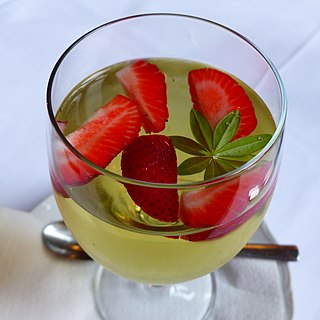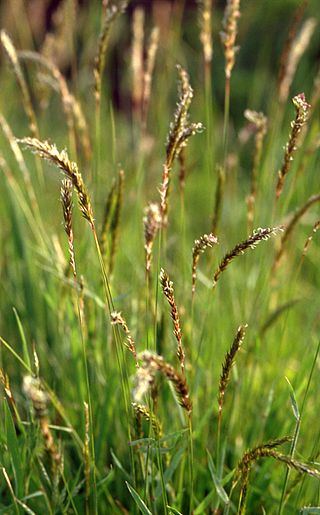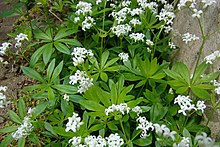
Spearmint, a species of mint (mentha) scientifically classified as Mentha spicata (,) also known as garden mint, common mint, lamb mint and mackerel mint, is native to Europe and southern temperate Asia, extending from Ireland in the west to southern China in the east. It is naturalized in many other temperate parts of the world, including northern and southern Africa, North America, and South America. It is used as a flavouring in food and herbal teas. The aromatic oil, called oil of spearmint, is also used as a flavoring and sometimes as a scent.

Prunus laurocerasus, also known as cherry laurel, common laurel and sometimes English laurel in North America, is an evergreen species of cherry (Prunus), native to regions bordering the Black Sea in southwestern Asia and southeastern Europe, from Albania and Bulgaria east through Turkey to the Caucasus Mountains and northern Iran.

Kalmia is a genus of about ten species of evergreen shrubs from 0.2–5 m tall, in the family Ericaceae (heath). They are native to North America and Cuba. They grow in acidic soils, with different species in wet acid bog habitats and dry, sandy soils.

The redcurrant or red currant is a member of the genus Ribes in the gooseberry family. It is native to western Europe. The species is widely cultivated and has escaped into the wild in many regions.

The curry tree or Bergera koenigii, is a tropical and sub-tropical tree in the family Rutaceae, native to Asia. The plant is also sometimes called sweet neem, though M. koenigii is in a different family to neem, Azadirachta indica, which is in the related family Meliaceae.

May wine, also known as Maitrank, Maiwein, Maibowle and Waldmeisterbowle, is the name of aromatized wine or punch made with it popular in Germany. May wine is served in the spring, traditionally on the May Day holiday. The base is made by steeping the fragrant creeping herb sweet woodruff that grows in the forests of Northern Europe in a white German wine. It is the specialty of the town of Arlon, in the south of Belgium.

Coumarin or 2H-chromen-2-one is an aromatic organic chemical compound with formula C9H6O2. Its molecule can be described as a benzene molecule with two adjacent hydrogen atoms replaced by an unsaturated lactone ring −(CH)=(CH)−(C=O)−O−, forming a second six-membered heterocycle that shares two carbons with the benzene ring. It belongs to the benzopyrone chemical class and considered as a lactone.

Alyxia stellata, known as maile in Hawaiian, is a species of flowering plant in the dogbane family, Apocynaceae, that is native to Hawaii. It grows as either a twining liana, scandent shrub, or small erect shrub, and is one of the few vines that are endemic to the islands. The leaves are usually ternate, sometimes opposite, and can show both types on the same stem. Flowers are quite inconspicuous and have a sweet and light fragrance of honey. The bark is most fragrant and exudes a slightly sticky, milky sap when punctured, characteristic of the family Apocynaceae. The entire plant contains coumarin, a sweet-smelling compound that is also present in vanilla grass, woodruff and mullein. Fruit are oval and dark purple when ripe. Maile is a morphologically variable plant and the Hawaiian names reflect this.

Potpourri is a mixture of dried, naturally fragrant plant materials used to provide a gentle natural scent, commonly in residential settings. It is often placed in a decorative bowl.

Galium verum is a herbaceous perennial plant of the family Rubiaceae. It is widespread across most of Europe, North Africa, and temperate Asia from Israel, Lebanon and Turkey to Japan and Kamchatka. It is naturalized in Tasmania, New Zealand, Canada, and the northern half of the United States. It is considered a noxious weed in some places.

Hierochloe odorata or Anthoxanthum nitens is an aromatic herb native to northern Eurasia and North America. It is considered sacred by many Indigenous peoples in Canada and the United States. It is used as a smudge in herbal medicine and in the production of distilled beverages. It owes its distinctive sweet scent to the presence of coumarin.

Sambucus nigra is a species complex of flowering plants in the family Adoxaceae native to most of Europe. Common names include elder, elderberry, black elder, European elder, European elderberry, and European black elderberry. It grows in a variety of conditions including both wet and dry fertile soils, primarily in sunny locations. The plant is widely grown as an ornamental shrub or small tree. Both the flowers and the berries have a long tradition of culinary use, primarily for cordial and wine.

Anthoxanthum odoratum is a short-lived perennial grass, commonly known as sweet vernal grass, that is native to acidic grassland in Eurasia and northern Africa. It is grown as a lawn grass and a house plant, due to its sweet scent, and can also be found on unimproved pastures and meadows. The specific epithet odoratum is Latin for 'odorous'.

Calycanthus floridus, or commonly known as the eastern sweetshrub, Carolina all spice, or spicebush, is a species of flowering shrub in the family Calycanthaceae. It is identifiable by its dark red flowers and fragrant scent. It is non-invasive and is found in the Southeastern United States region. The Nature Conservancy considers its conservation status to be G5, globally secure, indicating it is at low risk of extinction. It is presumed to have been extirpated from Ohio.

Galium triflorum is a herbaceous plant of the family Rubiaceae. It is widespread in northern Europe, eastern Asia, the Middle East and Indian subcontinent, and North America. The plant is considered a noxious weed in New York, Pennsylvania, Vermont, New Hampshire, Connecticut and Massachusetts.

Galium boreale or northern bedstraw is a perennial plant species of the Rubiaceae family. It is widespread over the temperate and subarctic regions of Europe, Asia and North America including most of Canada and the northern United States.

Polygonatum odoratum, the angular Solomon's seal or scented Solomon's seal, is a species of flowering plant in the family Asparagaceae, native to Europe, the Caucasus, Siberia, the Russian Far East, China, Mongolia, Korea, Nepal and Japan. In the United Kingdom it is one of three native species of the genus, the others being P. multiflorum and P. verticillatum.

Sarcococca confusa, the sweet box, is a species of flowering plant in the family Buxaceae, probably native to western China. It is an evergreen shrub growing to 2 m (7 ft) tall by 1 m (3 ft) broad, with glossy green ovate leaves and honey-scented white flowers in winter, followed by glossy black spherical fruits, 5 mm in diameter.
Aromatised wine is a wine flavoured with aromatic herbs and spices. These are classified by their alcohol content and the flavourings and other ingredients used. The European Union defines three categories which are: 'aromatised wine', 'aromatised wine-based drink' and 'aromatised wine-product cocktail'. Drinks which have an alcohol content of 1.2% abv or less, cannot be labelled as containing wine.

Prasophyllum odoratum, commonly known as the fragrant leek orchid, Rogers scented leek orchid or sweet leek orchid is a species of orchid endemic to south-eastern Australia. It has a single tubular leaf and up to fifty fragrant green and white flowers with reddish marks.




















